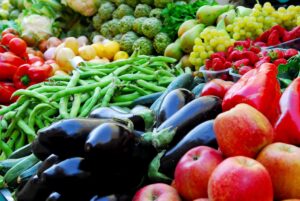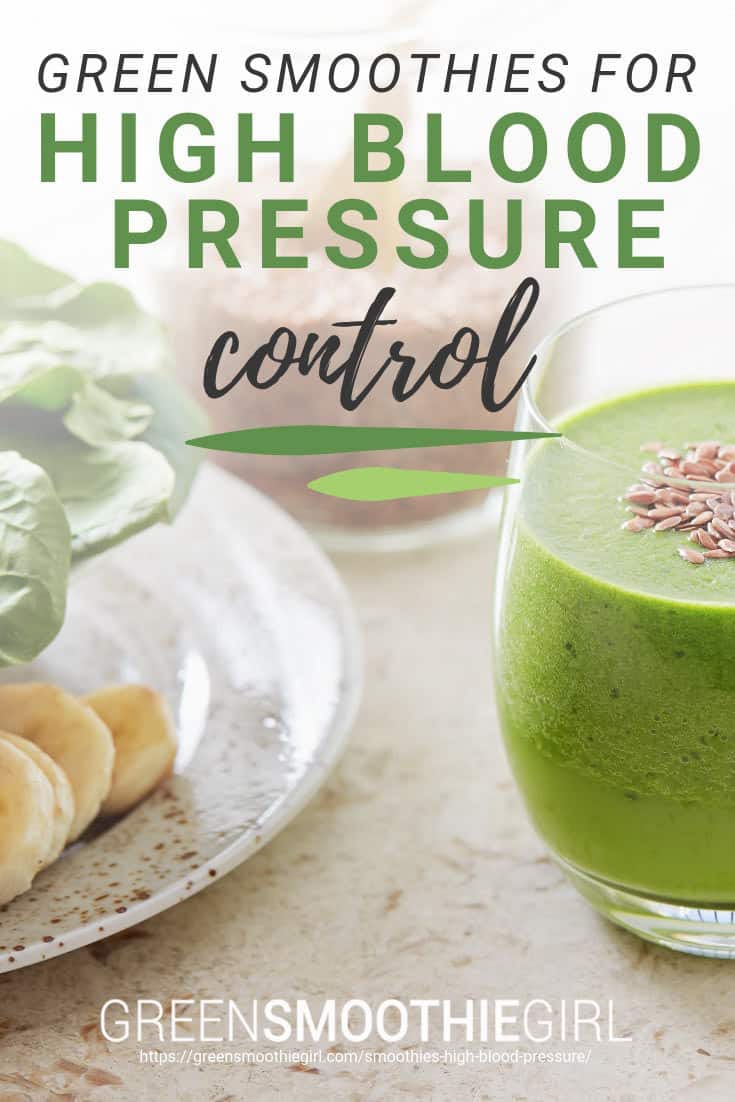Green Smoothies For High Blood Pressure Control

More than 108 million people in the United States have high blood pressure, or hypertension––that’s nearly half of the American population1. According to the Centers for Disease Control and Prevention (CDC), only one in four of those people have their blood pressure under control, and it’s usually thanks to some form of medication.
Did you know you can help manage hypertension naturally? Through a whole-foods diet, you can get all the nutrients you need to help regulate your blood pressure, minimize inflammation, and maintain your health.
Green smoothies are one of the easiest ways to get lots of nutrient-dense plant foods in your diet, and I have some delicious recipes for green smoothies for high blood pressure that will make your mouth as happy as your heart!
In this post:
- Foods to Avoid for High Blood Pressure
- Why Smoothies are Good for Regulating High Blood Pressure
- What Nutrients Will Help Decrease Blood Pressure?
- Green Smoothies for High Blood Pressure Control
Foods to Avoid for High Blood Pressure
One of the main reasons hypertension is so prevalent is because of the high levels of sodium in our packaged foods.
Sodium helps preserve the food so it can stay on the shelf longer, and manufacturers of processed foods have found that it makes their products more enticing—but sodium excess also causes cells to retain too much water. This increases the volume of your blood, making it harder for your heart to pump it properly and putting pressure in the vascular system2.
The Standard American Diet (SAD) is full of processed foods, so eliminating at least the worst sodium offenders is important, while also replacing them with whole foods that are as close to natural form as possible.
Here are some of the highest-sodium processed foods to avoid:
- Deli meats
- Crackers
- Chips
- Canned soups
- Pretzels
- Frozen, microwaveable dinners
- Frozen pizza
- Pickles in brine (not lacto-fermented)
Some varieties of these foods have been made with lower sodium, but in most cases, there are other additives and processes that still make them poor choices for eating.
And even many “low sodium” processed foods add up quickly to far exceed the CDC’s recommendation that we consume no more than 2,300 mg of sodium per day. 3
So, eating from the drive-thru, cans, and boxes of pre-packaged foods will continue to put you at risk for increasing cardiac and vascular problems.
Why Smoothies Are Good For Regulating High Blood Pressure
For those who are used to the SAD and don’t eat many whole fruits and vegetables, getting the recommended minimum of five cups a day4 might seem like a stretch.
Green smoothies are a great way to consume more fruits and vegetables, an essential step in controlling high blood pressure. One green smoothie can fit the entire five cups of greens, vegetables, and fruits into one delicious drink, offering up a great start to a day full of good nutrition—or a healthy snack or small meal, any time.

I’ve calculated that one quart of green smoothie yields about 10 servings of fruits and veggies. If we’re filling our smoothies with fresh, raw produce, we’re also getting the right amount of nutrients we need to help safely and naturally regulate blood pressure.
[Related: How Many Calories Are In A Green Smoothie?]
What Nutrients Will Help Decrease Blood Pressure?
Omega-3 Essential Fatty Acids (EFAs)
Foods that contain omega-3 EFAs have been found to lower blood pressure just as well as exercising and limiting salt intake, according to The American Journal of Hypertension5. There are lots of sources of omega-3s that are great for adding into smoothies, like flax seeds (which are more effective than any hypertensive drug on the market), chia seeds, and walnuts. Even flax and chia seeds’ omega-3s can be improved by sprouting them, or getting them already sprouted for you.
Calcium
Calcium works with magnesium to contract and relax muscles as needed, and muscle is what surrounds the arteries and veins, allowing the vessels to also contract and expand and thus regulating blood pressure. If calcium is deficient, it could cause the muscles to contract too much, creating higher blood pressure. Smoothie-ready foods loaded with calcium include kale, spinach, collard greens, almonds, sesame and chia seeds, rhubarb, and figs. Notice I didn’t include dairy? Many leafy greens actually contain more calcium than milk!
Magnesium
A deficiency of magnesium can also cause hypertension. Any constriction in blood vessels can cause blood pressure to rise because the blood cannot flow through as well, and magnesium is important for dilating (opening up) the blood vessels. The best sources of this mineral that go well in your daily smoothie include nuts and seeds (and their butters), spinach, swiss chard, and delicious cacao.
Potassium
This mineral is often prescribed to offset high sodium levels, so increasing it in your diet is a natural way to combat the imbalance. We need a higher ratio of potassium to sodium for optimal health than the average American is getting, as well, so it’s important to incorporate potassium-rich foods like bananas, apples, avocados, papaya, carrots, swiss chard, winter squash, flax and more into the diet. These foods are all great smoothie additions that offer a variety of beneficial phytonutrients. Bananas in particular are an excellent source of potassium and they make your smoothies creamier too!

Green Smoothies for High Blood Pressure Control
Using the above guidelines for creating smoothies that support blood pressure regulation, I have some delicious recipes for you, all adapted from my Big Book of Green Smoothies. These are all for several servings, so get your meal prep on!
Banana Split Smoothie
Who knew a banana split could be so good for you? This recipe takes your typical ice cream sundae flavors and turns them into a potent, heart-healthy blend. Greens provide the calcium and magnesium needed for proper blood vessel function, while the bananas bring the potassium that brings the body back into balance. For extra protein, fat, and fiber that make this a super-satisfying smoothie, chia and flax bring it all, including those valuable omega-3 EFAs.
Ingredients:
- 2 cups coconut water
- 1 bunch spinach
- 1 bunch kale
- 1 large spoonful almond butter
- 2 tbsp cacao powder
- 2 frozen bananas
- 1 handful frozen strawberries
- ¼ cup pineapple
- 1 tbsp chia seeds
- 1 tbsp flax meal
- optional: substitute 2 Tbsp GSG Sprouted TriOmega for the chia and flax
Directions:
Blend together in a high-powered blender until smooth.

Buttery Brew Smoothie
You don’t always have to make a salad with your lettuce. It’s a pretty mild vegetable that blends in well in a big green smoothie, especially one loaded with fruity flavor. If you can’t find sprouts and aren’t the DIY type, feel free to substitute with 2 tbsp of our GSG Sprouted TriOmega.
Ingredients:
- 2 ¾ cup water/ice
- 1 head butter lettuce
- ½ cup broccoli or alfalfa sprouts
- Spinach, added until blender mixture reaches 6 cup line
- ½ tsp stevia
- 2 bananas, frozen in chunks
- 2 cups papaya, including seeds
- 2 cups frozen blueberries
- 2 cups frozen fruit medley
Directions:
Blend the first four ingredients well. Add stevia and fruit and blend again until smooth. Serve immediately for best nutrition (sprouts oxidize quickly) or refrigerate up to 24 hours and shake well before serving.
Green Goddess Smoothie
Why do we soak almonds? To reduce the phytic acid content, an anti-nutrient that makes its vitamins and minerals less available to the body. Soaking makes them more absorbable and digestible, plus they get softer and easier to blend too. This mix can not only promote heart health with its range of cardiovascular-supporting nutrients, but can also give you some pretty good energy too. Much of the fat in coconut oil is made up of medium-chain triglycerides, which digest quicker than other fats, giving you easier energy to use throughout the day.
Ingredients:
- 2-3 cups water
- 1 handful soaked almonds
- 1 tbsp ground flax or sprouted ground flax
- 1 scoop protein powder
- 1 tbsp coconut oil
- ¼ cup dates or agave nectar (optional, to sweeten)
- 1 ½ cups frozen blueberries
- 2 large swiss chard leaves
- 2 large kale leaves
- 1 handful spinach leaves
- 1 frozen banana
- Ice (optional)
Directions:
Put the first six ingredients in a high-powered blender and blend well. Add fruit, green leafy veggies, and optional ice, then blend again until smooth.
Lettuce Be Green Smoothie
You’ve probably put lime in a smoothie before, but have you ever put the whole thing in the blender, peel and all? That’s where many of its nutrients are! Along with all the vitamins and minerals we talked about above, the limes also add some Vitamin C into the mix. Why is this important for heart health? Vitamin C helps support collagen production. Collagen is one of the most abundant proteins in our body that keep the tissues of our body strong, including the arteries.
Ingredients:
- 1 cup water/ice
- 1 ¾ cups water
- 1 head red leaf lettuce, washed
- Kale, added until blended mixture reaches 6 cup line
- 2 whole key limes (including peel)
- 1 avocado, peeled and pit removed
- 2 granny smith apples
- 1 banana, frozen in chunks
- 4 cups frozen mixed berries
- ¼ cup raw honey (local, if possible)
Directions:
Blend the first four ingredients until smooth. Add fruit and honey and blend until smooth. Serve immediately for best results or refrigerate for up to 24 hours and shake well before serving.
Sunflower Shower Smoothie
One of the many great benefits of green smoothies is that they are chock full of fiber, which is key in maintaining good heart health, according to Harvard Health6. People who routinely get enough fiber in their diet are less likely to suffer from metabolic syndrome, symptoms of which include high blood pressure. Start the day heart-strong with this recipe in the morning.
Ingredients:
- 2 ¾ cups water/ice
- 2 oz sunflower greens (sprouts)
- Romaine or bibb lettuce, added until blended mixture reaches 6 cup line
- ¼ whole lime, including peel
- 3 plums, pits removed
- 2 bananas, frozen in chunks
- 2 apples
- Frozen berries, added until container is very full
Directions:
Blend the first three ingredients until smooth. Add remaining ingredients and blend until smooth. Serve immediately for best results or refrigerate for up to 24 hours and shake well before serving.
Read next: How Digestive Enzymes Work -- and Why You're Probably Deficient

Disclosure: This post may contain affiliate links that help support the GSG mission without costing you extra. I recommend only companies and products that I use myself.

Sources:
- “Facts About Hypertension.” National Center for Chronic Disease Prevention and Health Promotion , Division for Heart Disease and Stroke Prevention. U.S. Department of Health & Human Services. January 28, 2020.
- Grillo, Andrea et al. “Sodium Intake and Hypertension.” Nutrients vol. 11,9 1970. 21 Aug. 2019, doi:10.3390/nu11091970
- “Get the Facts: Sodium and the Dietary Guidelines.” Centers for Disease Control and Prevention. October 2017.
- “Eat Healthy.” ChooseMyPlate. U.S. Department of Agriculture.
- Miller, P.E. et al. “Long-Chain Omega-3 Fatty Acids Eicosapentaenoic Acid and Docosahexaenoic Acid and Blood Pressure: A Meta-Analysis of Randomized Controlled Trials.” American Journal of Hypertension. Volume 27, Issue 7, July 2014, Pages 885–896, https://doi.org/10.1093/ajh/hpu024
- “Eat more fiber-rich foods to foster heart health.” Harvard Health Publishing. Harvard Medical School. April 2014.
Posted in: Green Smoothies, Health Concerns, Recipes, Whole Food


















Thanks Robyn, these recipes look amazing. I can’t wait to try them out!
I recently came across this smoothie diet but wasn’t too sure if I should try it out.
https://www.totalbeings.com/the-smoothie-diet-review/
Would love to get your thoughts on it.
Hi Daniel, as you know, Robyn believes in a whole food diet and smoothies are a great way to get those nutritious fruits and vegetables in one drink. If you incorporate her ideas and her recipes online or in her 12 Steps to Whole Foods Course, you will be well on your way!
Thank you!
Suffer from light kidney faileur so have to be careful with potassium
Banana can be substituted by avocado or…?
Also light heart faileur and Hashimoto’s (being denied by conventional physitian)
Trying to lose weight. Are these smoothies helpful for that too?
Basically, my question is really how to juggle with smoothies and foods when having more than one condition, and what is beneficial for one, isn’t recommended for the other…
HI Carmela, as we generally like to be able to help all of our followers out, sometimes we have to ask you to refer to your practitioner, Functional Medical Doctor or a naturopath that can do labs and follow your progress.
how often do you take this smoothies?
Hi Martha,
Green smoothies can be enjoyed on a daily basis but it is really up to your preference and schedule. And of course if you have any health considerations or take medications you will want to consult your healthcare practitioner.
Hi, these sound great! Thx so much for sharing them!
Should there be concern about all the sugar in the smoothies with fruit? I have osteoporosis and have read that fruit juice can be a cause.. not sure?!
Hi Susan, there is nothing wrong with carbs… in fact, your body NEEDS those complex carbs and your muscle feeds on glucose, which comes from fruit. Also, keep in mind that fruit sugar leaves your stomach within minutes of consumption never making it to the digestive tract — unlike processed sugar. A cold-pressed juice can cause a spike, however when the fiber is still intact, even when blended, will not create the same effect. If you are concerned about the sugar, you can stick to the lower glycemic ones like berries. There’s so much nutrition in fruit, I would not be afraid of it. As far as osteoporosis goes, consuming more fruits and vegetables is associated with greater done density and lower risk of osteoporosis. Hope this helps.
Do you strip the ribs out of the kale and chard or do you blend the whole leaves?
Hi Dianne, you can keep the ribs/stems of the kale in.
Thank you for this information which is so helpful, however is there also a smoothie for high cholesterol?
Hi Marianne, any of the green smoothies would work, even some of the ones with nuts. Of course, that being said, the rest of the diet should change to remove processed foods, decreased animal products following a whole foods diet, etc. Some people with heart disease may need to cut out oils but a major study says adding 2oz of nuts to your diet daily cuts your heart disease in half. Eating whole foods with nuts isn’t the problem. Eating fried food or oils is the problem. Hope this helps.
Thanks Robin, I will pass this to my Nephew, he has high blood pressure
Robyn, are you ever concerned about blood sugar levels with so much fruit ?
I’m always concerned about that when I see a lot of fruit in a recipe, even though I know the fruit has fiber.
Hi Patricia, there is nothing wrong with carbs… in fact, your body NEEDS those complex carbs and your muscle feeds on glucose, which comes from fruit. Also, keep in mind that fruit sugar leaves your stomach within minutes of consumption never making it to the digestive tract — unlike processed sugar. A cold-pressed juice can cause a spike, however when the fiber is still intact, even when blended, will not create the same effect. If you are concerned about the sugar, you can stick to the lower glycemic ones like berries. There’s so much nutrition in fruit, I would not be afraid of it.
I guess the bananas should be peeled before frozen. Whoops. lol
Any suggestions on a high powered blender that won’t break the bank but actually produces smooth smoothies?
I’m disabled and working on getting back to my Normal weight before my Accident (13st.) I’m now 20st and I’ve cut out all the Fatty foods & looking to Start a smoothly Diet.
What is the Best Recipes for Achieving my GOAL?.
Hi John, thanks for reaching out.
You might find this article useful:
https://greensmoothiegirl.com/smoothie-recipes-for-weight-loss/
—Lindsay, GreenSmoothieGirl